My Three Smiths
Reading in a plague year
To begin at the beginning: I blame Dame Hilary Mantel. On New Year’s Day 2020, 24 hours after an initial cluster of COVID-19 cases had been diagnosed in Wuhan, China, I was nose-deep in The Mirror & the Light, the magnificent doorstop conclusion to her Cromwell trilogy, soaking up the pageantry and intrigue of Henry VIII’s court. Mantel cast a spell; I was blissfully unaware of reports radiating outward from East Asia and then from Italy. Doomscrolling was future tense.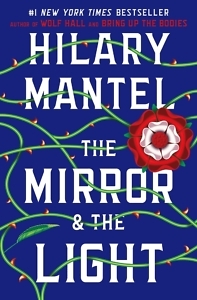
In those days I was bracing for another year of a Trump presidency and the unnerving possibility of his re-election. Books were my escape hatch: evenings spent in the glow of lamplight, tucked inside a loveseat, glass of merlot in hand, a mood the Danes would call hygge. Brooklyn dissolved into the Tower of London — I felt as though I were seated high in an opera box, peering over a gilt railing, absorbed by the players on a lit stage below: the wraithlike Jane Seymour, the deranged monarch, the Machiavellian Cromwell and his own slow march to the scaffold.
And yet mortality was emerging from the cold, hitching rides on jetliners from Wuhan, Milan, Brussels. I’d no sooner finished The Mirror & the Light when SARS CoV-2, the coronavirus, arrowed into New York City, triggering a lockdown on Friday, March 13. What had been true throughout the Trump administration grew more urgent. I already depended on books to buoy me through the rough seas of a troubled time; now we were all facing a tsunami. During a two-week stretch in April, the sirens screamed without letup. I could hear them in stereo, an atonal chorus of distress as ambulances sped up the Prospect Expressway, down Coney Island Avenue, across Cortelyou Road. All night long the blue flashes of emergency vehicles strobed through Venetian blinds. Sleep was a fool’s errand as death came for thousands of New Yorkers suddenly, in their kitchens, bathtubs, and beds.
Starved for the oxygen of normalcy, I burrowed down, a hibernation-in-reverse as the sun angled higher in the southern sky, tulips unfurled their bonnets. The Norway maples leafed, boughs tapping the windows in my bedroom, a pane of glass and a world apart. Longer evenings, warm breezes! The Earth turned on its axis, indifferent. I masked up for a run to the deli, washed hands again and again, and then immersed myself in Summer, the Scottish novelist Ali Smith’s final installment to her seasonal quartet. Back to the basics, I thought.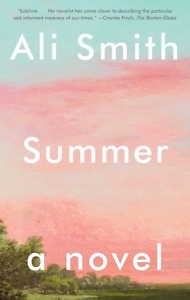
Colloquial, gleaming with postmodernist flourishes, Smith’s novels are Monet-like murals of language and storytelling, politics and art. She dares to be funny, to be angry. She’s hyperbolic in all the ways I can’t express. She conceived the quartet as a larger work unfolding in real time: Summer opens in February 2020 as the pandemic takes root in England, but also includes references to the George Floyd protests later in the year. (She was still writing in mid-June.) A few characters from previous books appear here, transformed, tapping an inner resilience, searching for beauty amid the panic. Smith shifts back and forth in time, untethering the narrative and allowing it to float free — does this track with your 2020? What’s past is prologue? What day is it, exactly? There’s nothing linear about now, two months ago, last spring, next week, and the next. A favorite moment: in Summer there’s a letter dated a few days after I’d read the page proofs.
***
As I was walling myself off from SARS CoV-2, the novelist and critic Zadie Smith was bursting through the cage of lockdown, decamping with her family from Manhattan to her friends’ country home, and then back to her native London as the “global shit hit the fan.” She penned a series of essayettes she titled Intimations, an allusion to Wordsworth’s “Ode on Intimations of Immortality.” Doom looms everywhere: Isolation closes in on her as she runs errands around Greenwich Village, hops a bus near Stonebridge Estate in England. She searches for meaning in the concrete world. She wonders why she and two other middle-aged women are mesmerized by flowers in the Jefferson Market Garden; she delights in a “homeless, legless” Black man she recognizes on Broadway; she’s charmed by an “IT Guy” on a hoverboard, his “coiled, unpredictable Afro.” And like Ali Smith, she turns to literature to anchor her in the storm, dipping into the Roman author Marcus Aurelius, among others. When in doubt, there’s the canon. Back to the basics.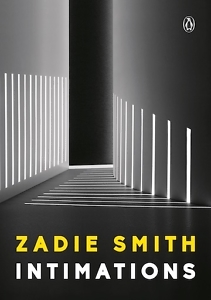
I read Intimations in a single sitting — it weighs in at under 100 pages — and was tearing up by the final page, gutted by the blue fire of Zadie Smith’s rage, the lines she draws between history whipping around her and her own labile emotions. Sound familiar? She brilliantly twines 2020’s most prominent news stories, COVID-19, and the surge in antiracism demonstrations worldwide: “You start to think of contempt as a virus. Infecting individuals first, but spreading rapidly through families, communities, peoples, power structures, nations. Less flashy than hate. More deadly … Patient zero of this particular virus stood on a slave ship four hundred years ago, looked down on the sweating, bleeding, moaning mass below deck and reverse-engineered an emotion — contempt — from the situation he, the patient himself, had created. He looked at the human beings he had chained up and noted that they seemed to be the type of people who wore chains. So unlike other people. Frighteningly unlike!” Racism as a chronic illness of the soul.
What I most admire in Zadie Smith’s work, after her pitch-perfect sentences, is her clear-eyed gaze at the things that fester — not only beneath her own skin, but also within the body politic. In an upside-down year she pulls me right-side up with her honesty, valor, and generosity. Intimations is slender but punches above its weight, probing how a rampaging pathogen reveals who we are.
***
The works of Marcus Aurelius also attracted rock legend and National Book Award winner Patti Smith during 2016, a fallow period she recounts in her gorgeous Year of the Monkey. New Year’s Day finds Smith in her own pre-COVID-19 flux. She’s just finished a show at San Francisco’s famous Fillmore, upset and distracted, as her longtime friend Sandy languishes in a coma on the other side of the Golden Gate Bridge, his prognosis poor. She withdraws by heading down the coast and checking into Santa Cruz’s Dream Inn. She sleeps and dreams; she devours robust meals; she collects candy wrappers (a motif throughout the book); she banters with the Inn’s sign, which magically speaks to her. The real becomes surreal.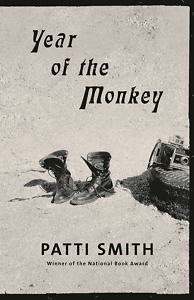
From here she journeys across the world, penetrating her own heart of darkness, a dreamscape inspired by writers she reveres, from Lewis Carroll to Roberto Bolaño. A pier in Southern California, the Arizona desert, her familiars in New York: All are waking shadows of the real forms that stalk her slumber. Plato viewed through the looking glass. She broods over artists and the myriad impulses that drove them, from high craft to pop culture: Nijinsky, Belinda Carlisle of the Go-Go’s, even the Marx Brothers. She needs them all as she confronts her friend’s medical crisis and the approach of her 70th birthday.
Ali Smith is sweeping and slangy; Zadie Smith is precise and political. Both are fortunate to have Cambridge educations and erudition in their literary toolboxes. By contrast, Patti Smith is an American Everywoman, roaming a continent, dispirited but determined to squeeze out all the dreams that fail to add up to the American Dream. Her prose is terse but assured. She writes just how she’d speak if you ran into her at a diner, her fork stabbing a plate of scrambled eggs and steak.
And she’s just the right item on the quarantine menu. Year of the Monkey drew me back to Smith’s punk voice, how it grates its rough edges into the sublime: “Desire is hunger is the fire I breathe.” Her poses on those album covers, confidence tinged with vulnerability. She writes about vulnerabilities of recent years, public and private, as Trump escaped the laws of political gravity; now she’s speaking directly to me as I swallow aspirin to ease a migraine.
“Across America one light after another seemed to burn out. The oil lamps of another age flickered and died. The sign was silent, but the books on my night table beckoned … I notice that I cry more when I watch television, triggered by romance, a retiring detective shot in the back while staring into the sea, a weary father lifting his infant from a crib. I notice that my own tears burn my eyes, that I am no longer a fast runner and that my sense of time seems to be accelerating.”
The abrupt about-face, the reversal of fortune, the tear in the fabric of reality: These moments inspire Patti Smith. We don’t know what we don’t know. Is there any more essential insight? In a year in which our expectations have been shredded — our once-in-a-century pandemic year — I trust Smith’s intuition. Just go with the flow. End the conversation. Listen rather than speak.
Read and dream.
***
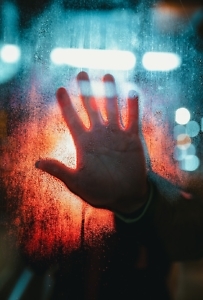
“Those years were devoid of any logic save that of the dreamwork,” Joan Didion opines in “The White Album,” her iconic essay on the 1960s. Didion’s hindsight is 20/20, of course, but my three Smiths discern, unerringly, that 2020’s logic (if you could call it that) moves like a dream’s. As wordsmiths, they wrench contour and texture from our common nightmares, a discipline found only on the page. These women fall back on literature: Ali Smith on Shakespeare and Dickens, Zadie Smith on Marcus Aurelius and Jun’ichirō Tanizaki, Patti Smith on Allen Ginsberg and Roberto Bolaño. And why not? Part of me has done the same in quarantine: try not to get sick and pore over the books that I’ve put aside over the years. Most evenings I’ve read sentences aloud, marveling at their imagery, tongue curled around their cadences.
I’ve sheltered in place with the written word.
But there’s danger here. We can become distanced from the world. Tragedy is one thing when it’s beautifully painted in a story, quite another in the ERs of hospitals from Queens to El Paso to Salt Lake City. Triage performed on patients gasping for breath. Nurses holding out iPhones so mothers can say goodbye to their children. Morgues set up in parking lots, corpses packed in sacks of ice.
Which is one reason why I’ve pushed to read outside of my comfort zone. Each morning I catch up on the tweets of our leading epidemiologists and science journalists; their wisdom, wit, and wonder have restored my faith in social media. From January 12, when a Chinese researcher posted the sequenced genome of SARS CoV-2 on the internet, right through to this month, when the first efficacious doses of vaccine will roll out, we’ve watched up close one of the greatest scientific feats in human history. In record time, teams of clinicians, paired with Big Pharma, have rushed to pull off the impossible. And their dispatches from the front lines, while often horrific, have also kept me well informed in a plague year, picking up where literature leaves off.
I suspect my three Smiths would approve.

Copyright © 2020 by Hamilton Cain. All rights reserved. Hamilton Cain is the author of This Boy’s Faith: Notes from a Southern Baptist Upbringing and a frequent reviewer for O, the Oprah Magazine; the Minneapolis Star Tribune; and other venues. A native of Chattanooga, he lives in Brooklyn, New York.


